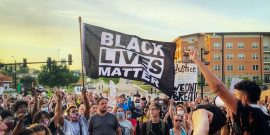The Limits to California’s Power
I thank Sean Beienburg, Spencer Klavan, Brent Orrell, and Richard Samuelson for their generous and bracing responses to my essay on California, I take comfort that they seem to mostly agree with my thesis that California no longer is, as it was during what I have called the Midcentury Moment, a harbinger of the America to come. Our differences seem to be marginal.
They focus productively on different points at which California moved from harbinger to outlier. Sean Beienburg, citing his Arizona State colleague Donald Critchlow, notes that the entertainment industry—“Hollywood”—has not always tilted left. During the Midcentury Moment it produced movies and television shows aimed at a universal audience, one that reflected and endorsed the values cherished by a large majority of the American people. That started changing in the 1970s, and by 1989 Ronald Reagan in his farewell address was lamenting the lack of “well-grounded patriotism” in that decade’s movies and television.
Richard Samuelson sees the 1970s as a turning point, as political leadership moved from Pat Brown (in public office from 1942 to 1966) to Jerry Brown (in public office, on and off, from 1970 to 2018), and as public employee unions established their hold on bureaucracies which had nurtured growth from the New Deal to the 1960s but have been stifling growth ever since.
Brent Orrell sees a break in the mid-1990s, when the Republican Party suddenly ceased to be competitive, and worries that something like that may happen nationally, in response to the particular politics of the very un-Californian Donald Trump.
Spencer Klavan, having fled the Left Coast and fearing “California will catch up to me,” sees the threat as more recent, in the Biden administration legislative agenda that seems designed to California-ize America. He is troubled by the sight of two Bay Area pols, Nancy Pelosi, and Kamala Harris, flanking the president as he speaks to a joint session of Congress.
Perhaps naively, I see these fears as exaggerated. The public employee unions’ sway is limited to states with a minority of the nation’s population, and the finally retired Jerry Brown never captured the nation’s imagination. The nation has not seen, as California has since the 1990s, a multi-decade mass departure of what I called “middle-income, middlingly-educated, family-raising Americans.” Pelosi, after barely clinging to her House majority in 2020, will surely retire next year; Harris’s negative poll numbers after just a few months as vice president, suggest that voters have spotted her as a lightweight; and it’s by no means apparent that all or even most of the Biden legislative agenda will pass.
As for Richard Samuelson’s anecdotal evidence that his first-generation students (at least the males) are rejecting “the woke agenda” and “the ideology or religion of a class of (mostly) white millionaires and professionals who want to keep their position in society by (perversely and paternalistically) claiming to represent the true interests of non-white voters,” didn’t we just see the same impulse among the black and Latino voters in New York City who rejected leftist mayoral candidates and voted for the black ex-NYPD cop Eric Adams? And didn’t we see California voters in 2020 rejecting racial quotas and preferences by a wider margin than they did in 1996?
These thoughtful responses got me thinking about how California’s economic base has changed over the last half-century. When I sat down to write the California state section of the first Almanac of American Politics in 1971, it seemed to me that the state’s two major metropolitan areas had very different economic bases.
Since 1989 the economic bases—and psychic identities—of both major California metro areas have been transformed. High-tech has replaced food in the Bay Area, as Silicon Valley became synonymous with personal computers and the Internet. And Southern California’s aviation and defense industries suddenly withered away in the early 1990s, the victims of defense cuts and government-forced mergers following America’s victory in the Cold War.
The San Francisco Bay Area, after its sudden beginnings in the Gold Rush period, had an economy based on food—processing and distributing the agricultural largesse of the Central Valley and the various Coastal microclimates and transporting it to the rest of the world. I did not notice then that the scions of the Bay Area’s wealthy families had turned into the venture capitalists who were investing shrewdly and often with enormous payoffs in the high-tech firms we call Silicon Valley. These men came from Progressive Republican backgrounds going back to Hiram Johnson and, as in New England, their offspring and successors have in overwhelming numbers become liberal Democrats.
Metropolitan Los Angeles, still spreading in 1971 inexorably through the orange groves of Orange County and out into the increasingly parched turf of the Inland Empire, was of course linked in the public mind with Hollywood, but its great growth during the Midcentury Moment was linked more to the aircraft industry and defense contractors. Douglas, Lockheed, Northrop, North American Aviation, Rockwell, and Hughes Aircraft all built operations during and after World War II in the Los Angeles Basin, with its good year-round weather for flying and its fast-growing labor force. By 1989, aviation-related firms accounted for one out of 12 jobs in the metro area.
Since 1989 the economic bases—and psychic identities—of both major California metro areas have been transformed. High-tech has replaced food in the Bay Area, as Silicon Valley became synonymous with personal computers and the Internet. And Southern California’s aviation and defense industries suddenly withered away in the early 1990s, the victims of defense cuts and government-forced mergers following America’s victory in the Cold War. Engineers and support personnel, people who leaned Republican politically, left California for jobs elsewhere.
That left Hollywood as the culturally dominant economic force in metro Los Angeles—a Hollywood whose products were no longer aimed at a universal American audience, but were aimed at niche audiences, from blockbusters aimed at the Chinese market and adolescent males who enjoy watching things betting blown up, to liberal cultural viewers interested in different genres of streaming television. The Hollywood of the Midcentury Moment delivered a product aimed at and influenced by the era’s Midwestern-heavy migration of the time. The Hollywood of recent decades, however, has been almost entirely uninterested in and affected by this era’s Mexican-heavy migration. From the West Side’s hillsides, its eyes pass over the grid of the Los Angeles Basin to markets and audiences culturally akin but geographically distant.
Silicon Valley and post-Midcentury Moment Hollywood are peopled almost entirely by what California author Joel Kotkin has dubbed gentry liberals, college-educated whites whose leftish views are based more on abstract theorizing than on concrete everyday experience. But California’s dominance of the high-tech and entertainment industries means that their ethos cannot be duplicated in mass quantities elsewhere. California remains the harbinger—of California.


